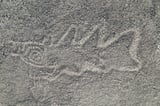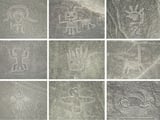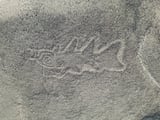AI Uncovers 303 New Nazca Geoglyphs, Doubling Known Ancient Artworks in Peru
September 23, 2024
In a groundbreaking discovery, scientists have mapped 303 new geoglyphs in the Nazca Desert of southern Peru using artificial intelligence, effectively doubling the previously known total of these ancient artworks.
Archaeologist Masato Sakai from Yamagata University announced the findings, emphasizing the significant role of AI in quickly and accurately mapping the distribution of these geoglyphs.
The AI model developed by the research team is particularly adept at identifying faint geoglyphs in aerial images of the Nazca Pampa, which covers an area of 400 square kilometers.
The newly identified glyphs are primarily relief-type, which are smaller and more challenging to detect than the larger line-type glyphs, with many depicting humans and domesticated animals.
This study, published in the journal PNAS, categorizes the geoglyphs into two main types: relief-type and line-type, highlighting their differences in style, size, motifs, and distribution.
The purpose of these massive geoglyphs, created by the Nazca civilization between 200 BC and 700 AD, remains a mystery, with theories suggesting they may have served astronomical or spiritual functions.
Many of the geoglyphs are strategically located near ancient travel paths, indicating they were designed to be seen by those journeying through the desert.
Among the newly discovered glyphs are depictions of various animals and abstract figures, contributing to a total of over 700 identified geoglyphs in the region.
Karsten Lambers from Leiden University noted the significance of the AI analysis but cautioned that it may not reveal all geoglyphs, particularly those that are less visible.
Prior to this discovery, around 430 geoglyphs had been documented, primarily due to advancements in satellite imagery over the last two decades.
These ancient motifs provide valuable insights into the cultures and beliefs of early civilizations, with origins dating back over 2,000 years.
The Nazca lines, designated as a UNESCO World Heritage Site in 1994, continue to be a focus of research and exploration, revealing the rich history of the Nazca civilization.
Summary based on 19 sources
Get a daily email with more Tech stories
Sources

Newsweek • Sep 23, 2024
Hundreds of Mysterious Ancient Nazca Land Artworks Found with Aid of AI
Gizmodo • Sep 24, 2024
AI Survey Reveals Hundreds of 'Nazca Line' Geoglyphs
Smithsonian Magazine • Sep 24, 2024
See Newly Discovered Nazca Drawings That Depict Llamas, Human Sacrifices and More
Phys.org • Sep 24, 2024
Archaeologists use AI to find hundreds of geoglyphs in Peru's Nazca Desert